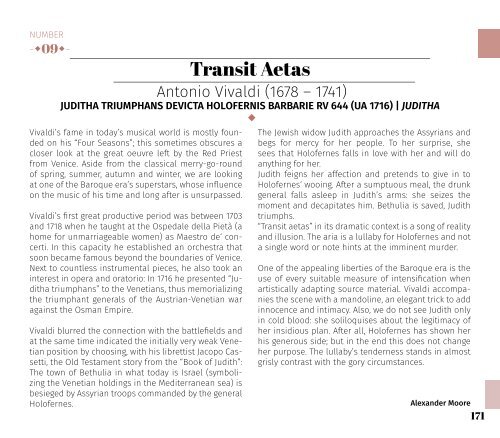Booklet "favola in musica.alte neue musik"
Enjoy the 216 pages fairy tale book inspired booklet of "favola in musica. early new music" in German and English with over 100 photographs, well researched musical texts to each aria, translations of all aria texts in German and English and biographies of all participating members. Music from renaissance, baroque and present time - 3 world premiere recordings from early music (Antonio Caldara, Sebastian Durón) - 2 world premiere recordings of contemporary music (Wolfgang Mitterer) - 1 bonus music-video (included on the CD) Deluxe Edition in a high-quality CD-Hardcover-Digibook, 216 costly designed pages with photos and texts 1607. ensemble for early & new music: Maria Weiss, voice, artistic director Rosario Conte, theorbo Gyöngy Erödi, cello Wolfgang Mitterer, composer Awarded the Pasticciopreis 2015 in Radio Österreich 1 »favola in musica« (eng. fairy tale in music) is the debut-album of the mezzo-soprano Maria Weiss, who designed this album as a musical fairy taie. It is the searching for the New within the Old and for the Old within the New. Developing this album,Maria Weiss lifted some treasures to light, so e.g. she discovered in the archives an aria of the forgotten opera of the composer Antonio Caldara. She also asked the composer and performer Wolfgang Mitterer, to reate two new works for this album. If you engage into this musical journey, you can also find the words of Monteverdis L'Orfeo but in an competely new contemporary way. Enjoy!
Enjoy the 216 pages fairy tale book inspired booklet of "favola in musica. early new music" in German and English with over 100 photographs, well researched musical texts to each aria, translations of all aria texts in German and English and biographies of all participating members.
Music from renaissance, baroque and present time
- 3 world premiere recordings from early music (Antonio Caldara, Sebastian Durón)
- 2 world premiere recordings of contemporary music (Wolfgang Mitterer)
- 1 bonus music-video (included on the CD)
Deluxe Edition in a high-quality CD-Hardcover-Digibook, 216 costly designed pages with photos and texts
1607. ensemble for early & new music:
Maria Weiss, voice, artistic director
Rosario Conte, theorbo
Gyöngy Erödi, cello
Wolfgang Mitterer, composer
Awarded the Pasticciopreis 2015 in Radio Österreich 1
»favola in musica« (eng. fairy tale in music) is the debut-album of the mezzo-soprano Maria Weiss, who designed this album as a musical fairy taie. It is the searching for the New within the Old and for the Old within the New. Developing this album,Maria Weiss lifted some treasures to light, so e.g. she discovered in the archives an aria of the forgotten opera of the composer Antonio Caldara. She also asked the composer and performer Wolfgang Mitterer, to reate two new works for this album. If you engage into this musical journey, you can also find the words of Monteverdis L'Orfeo but in an competely new contemporary way. Enjoy!
Sie wollen auch ein ePaper? Erhöhen Sie die Reichweite Ihrer Titel.
YUMPU macht aus Druck-PDFs automatisch weboptimierte ePaper, die Google liebt.
NUMBER<br />
-•09•-<br />
Antonio Vivaldi (1678 – 1741)<br />
•<br />
JUDITHA TRIUMPHANS DEVICTA HOLOFERNIS BARBARIE RV 644 (UA 1716) | JUDITHA<br />
Vivaldi’s fame <strong>in</strong> today’s <strong>musica</strong>l world is mostly founded<br />
on his “Four Seasons”; this sometimes obscures a<br />
closer look at the great oeuvre left by the Red Priest<br />
from Venice. Aside from the classical merry-go-round<br />
of spr<strong>in</strong>g, summer, autumn and w<strong>in</strong>ter, we are look<strong>in</strong>g<br />
at one of the Baroque era’s superstars, whose <strong>in</strong>fluence<br />
on the music of his time and long after is unsurpassed.<br />
Vivaldi’s first great productive period was between 1703<br />
and 1718 when he taught at the Ospedale della Pietà (a<br />
home for unmarriageable women) as Maestro de‘ concerti.<br />
In this capacity he established an orchestra that<br />
soon became famous beyond the boundaries of Venice.<br />
Next to countless <strong>in</strong>strumental pieces, he also took an<br />
<strong>in</strong>terest <strong>in</strong> opera and oratorio: In 1716 he presented “Juditha<br />
triumphans” to the Venetians, thus memorializ<strong>in</strong>g<br />
the triumphant generals of the Austrian-Venetian war<br />
aga<strong>in</strong>st the Osman Empire.<br />
Vivaldi blurred the connection with the battlefields and<br />
at the same time <strong>in</strong>dicated the <strong>in</strong>itially very weak Venetian<br />
position by choos<strong>in</strong>g, with his librettist Jacopo Cassetti,<br />
the Old Testament story from the “Book of Judith”:<br />
The town of Bethulia <strong>in</strong> what today is Israel (symboliz<strong>in</strong>g<br />
the Venetian hold<strong>in</strong>gs <strong>in</strong> the Mediterranean sea) is<br />
besieged by Assyrian troops commanded by the general<br />
Holofernes.<br />
Transit Aetas<br />
The Jewish widow Judith approaches the Assyrians and<br />
begs for mercy for her people. To her surprise, she<br />
sees that Holofernes falls <strong>in</strong> love with her and will do<br />
anyth<strong>in</strong>g for her.<br />
Judith feigns her affection and pretends to give <strong>in</strong> to<br />
Holofernes‘ woo<strong>in</strong>g. After a sumptuous meal, the drunk<br />
general falls asleep <strong>in</strong> Judith’s arms: she seizes the<br />
moment and decapitates him. Bethulia is saved, Judith<br />
triumphs.<br />
“Transit aetas” <strong>in</strong> its dramatic context is a song of reality<br />
and illusion. The aria is a lullaby for Holofernes and not<br />
a s<strong>in</strong>gle word or note h<strong>in</strong>ts at the imm<strong>in</strong>ent murder.<br />
One of the appeal<strong>in</strong>g liberties of the Baroque era is the<br />
use of every suitable measure of <strong>in</strong>tensification when<br />
artistically adapt<strong>in</strong>g source material. Vivaldi accompanies<br />
the scene with a mandol<strong>in</strong>e, an elegant trick to add<br />
<strong>in</strong>nocence and <strong>in</strong>timacy. Also, we do not see Judith only<br />
<strong>in</strong> cold blood: she soliloquises about the legitimacy of<br />
her <strong>in</strong>sidious plan. After all, Holofernes has shown her<br />
his generous side; but <strong>in</strong> the end this does not change<br />
her purpose. The lullaby’s tenderness stands <strong>in</strong> almost<br />
grisly contrast with the gory circumstances.<br />
Alexander Moore<br />
171





